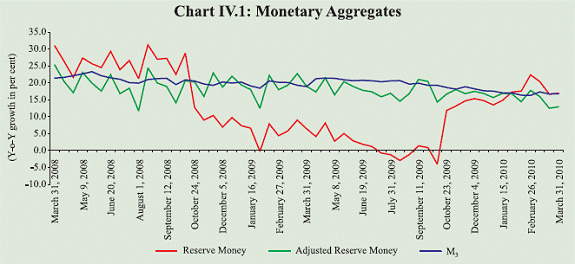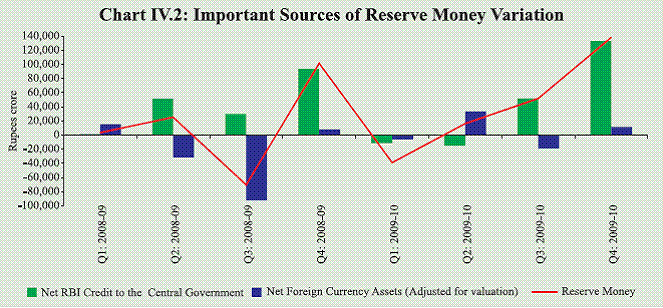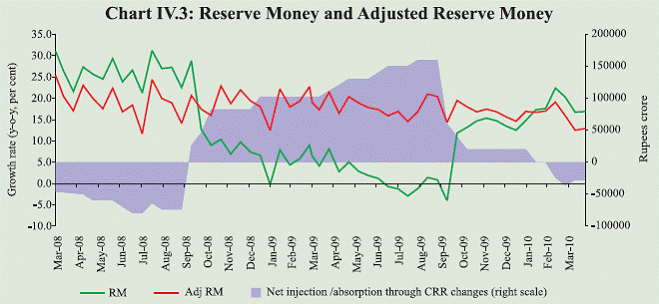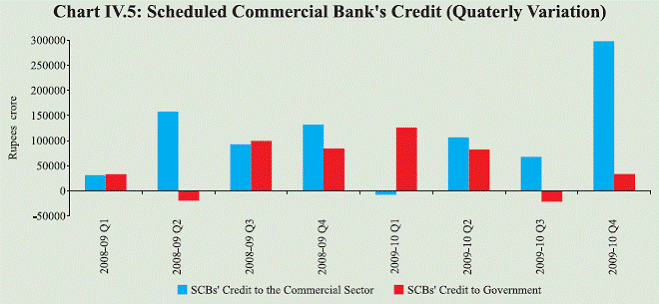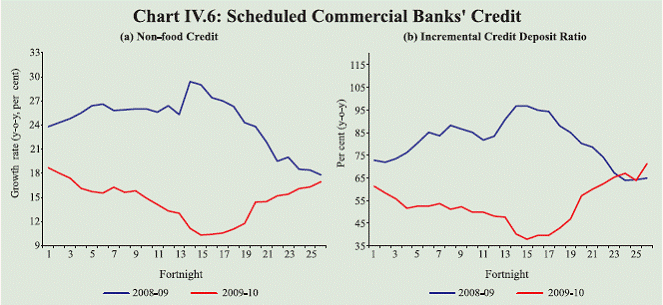IV. Monetary Conditions
During the first half of 2009-10, growth in both broad money (M3) and non-food credit decelerated. This reversed course during the second half reflecting the pull of economic recovery. While non-food credit, which had been decelerating since October 2008 reached its inflexion point in November 2009, money growth turned around in March 2010. By the end of the financial year, growth in both M3 and non-food credit exceeded the Reserve Bank’s indicative projections of growth of 16.5 per cent and 16.0 per cent, respectively. During the year, there was a slowdown in the pace of deposit mobilisation by the banking system, mainly due to the gradual decline in interest rates on time deposits in lagged response to the lower policy rates. With the increasing demand for credit from the banking system, deposit mobilisation has begun to gain strength, and deposit rates have also moved up in the recent period. Even after the absorption of Rs.36,000 crore through the 75 basis points hike in CRR effected in February 2010, liquidity conditions have remained comfortable, as evident from the reverse repo operations under the LAF in the recent weeks. IV.1 During the crisis, maintenance of ample liquidity and lower policy rates were used by the Reserve Bank as the key channels to stimulate private demand and thereby contain the pace of slowdown in economic activity. The interest rate transmission through lower lending rates started becoming visible with a lag. When the private demand for credit remained depressed and decelerated till the middle of Q3 of 2009-10, the flow of resources from the non-banking sources to the commercial sector increased. The recent upturn in monetary and credit aggregates provides additional evidence that the recovery is taking hold. IV.2 In 2009-10, growth in reserve money decelerated up to October and thereafter gradually rose back to the growth rate prevailing in September 2008, i.e., before the onset of the global financial crisis. In contrast, reserve money adjusted for the first round impact of CRR change, exhibited less volatility and followed a mildly decelerating trend for the year. IV.3 Growth in broad money (M3) showed deceleration throughout the year, with a moderate turnaround seen in March 2010 (Chart IV.1 and Table IV.1). This was on account of deceleration in aggregate deposits on the components side of M3. On the sources side of M3, the deceleration was driven by the relatively weak demand for credit from the commercial sector during the first half of 2009-10, combined with moderation in banking system’s credit to the Government during the second half of 2009-10. After a phase of deceleration, there has been a revival in the flow of bank credit since November 2009, as a result of which the Reserve Bank’s indicative target of 16.0 per cent credit growth for the year was exceeded by mid-March 2010. The improved flow of credit from the banking sector in conjunction with higher availability of resources from the nonbanking sources (both domestic as well as foreign) led to a significant increase in total flow of financial resources to the commercial sector, thereby financing the activities underpinning the economic recovery that is underway. Reserve Money IV.4 In 2008-09, the deceleration in the growth rate of reserve money was primarily on account of decline in bankers’ deposits with the Reserve Bank on the components side of reserve money (due to a net reduction in CRR by 250 basis points during the year) and decline in foreign currency assets (on account of capital outflows) on the sources side of reserve money. During 2009-10, the deceleration continued up to October. This was mainly due to decline in bankers’ deposits (since growth in banks’ aggregate deposits decelerated even as the CRR stayed unchanged at 5.0 per cent) on the components side of reserve money and decline in Reserve Bank’s credit to the Centre, reflecting increased reverse repo operations1 and increase in Centre’s surplus on the sources side of reserve money. As the outstanding reverse repo balances and open market operations declined October 2009 onwards, net Reserve Bank credit to the Centre became the important driver of acceleration in reserve money growth.
IV.5 For the entire financial year 2009- 10, the decline in MSS balances by Rs.85,340 crore (through unwinding and de-sequestering of balances to the Government) was the largest source of increase in reserve money, accounting for more than 50 per cent of the Rs.1,67,281 crore increase in reserve money. The other major source was open market purchases. LAF operations and Centre’s surplus with the Reserve Bank played a significant role in quarter to quarter movements in net Reserve Bank credit to the Centre and hence in reserve money. IV.6 The foreign currency assets of the Reserve Bank (adjusted for valuation) were the dominant source of variations in reserve money in the past five years. During 2009- 10, net accretion to foreign currency assets was the highest during the second quarter (Chart IV.2). In the last two quarters of 2009-10, however, the expansion in reserve money was not affected much by the moderate contraction and the subsequent expansion in foreign currency assets of the Reserve Bank. The significant movement in the net non-monetary liabilities of the Reserve Bank was mainly on account of the movement in the valuation of foreign exchange assets of the Reserve Bank. IV.7 During the fourth quarter of 2009- 10, reserve money growth on the components side was led by the increase in bankers’ deposits with the Reserve Bank. This was on account of the increase in CRR by 75 basis points in February 2010. Currency in circulation also increased in line with the increased economic activity in the country (Table IV.2). On the sources side, net Reserve Bank credit to the Centre accounted for nearly the entire increase in reserve money (Chart IV.2). The increase in net Reserve Bank credit to the Centre was mainly due to the reduction in the Government’s cash surplus with the Reserve Bank. The other factor contributing to increase in net Reserve Bank credit to the Centre was decline in outstanding reverse repo balances2, which reflected the impact of the absorption of part of the excess liquidity in the system by the hike in the CRR as well as some tightening of the overall liquidity conditions resulting from the advance tax payments during the first fortnight of March 2010. There was also a reduction in MSS balances with the Reserve Bank due to unwinding (Rs.11,036 crore in the first week of January 2010) and de-sequestering (Rs.5,000 crore on March 11, 2010).
IV.8 Since bankers’ deposits with the Reserve Bank, a key determinant of reserve money on the components side, change in response to variations in CRR effected by the Reserve Bank as part of its monetary policy actions, it is often useful to analyse the behaviour of reserve money adjusted for the policy induced part of the change in base money. Adjusting the reserve money series for injection/absorption through CRR changes gives the adjusted reserve money series. The reserve money growth for the last few fortnights of 2009-10 exceeds the adjusted reserve money growth, reflecting the impact of the hike in CRR in February 2010 that led to absorption of about Rs.36,000 crore of surplus liquidity from the system (Chart IV.3). Money Supply IV.9 Broad money growth followed the growth pattern of its largest component – aggregate deposits. Since there was gradual deceleration in aggregate deposits, led primarily by time deposits, money growth decelerated during the year (Table IV.3). Due to the softening of interest rates, there was deceleration in the growth of time deposits through the year, with an erratic pattern in the closing fortnights of 2009-10 (Chart IV.4 a). Since April 2009, returns on small savings have remained higher than that of time deposits, leading to rising inflows since August 2009, after a period of 20 consecutive months of outflows. As the interest differentials over time deposits became more attractive, the rate of accretion into the small savings schemes increased in each successive month up to February 2010, i.e., the latest period for which data are available (Chart IV.4 b).
IV.10 On the sources side, the main driver of M3 has been the banking system’s credit to the Government, while credit to the commercial sector also showed revival in the last quarter of 2009-10. A quarter-wise analysis reveals that incremental credit extended by scheduled commercial banks (SCBs) in absolute terms in the fourth quarter of 2009-10 was the highest in last two years (Chart IV.5). After showing an absolute decline in the third quarter of 2009-10, SCBs’ credit to the Government increased during the fourth quarter, when the Government’s borrowing programme was completed. IV.11 Reflecting the revival in flow of credit from the SCBs, the non-food credit growth was 16.9 per cent by end-March 2010 as against the Reserve Bank’s indicative trajectory of growth of 16 per cent (Chart IV.6 a). In the year up to October 2009, deceleration in non-food credit had continued and reached the low of 10.3 per cent. As the economic recovery is increasingly becoming more broad-based, with industrial output exhibiting particularly strong acceleration in recent months, there is a significant revival in credit demand since end-November 2009 and the incremental credit deposit ratio has also risen steadily in the second half of 2009-10 (Chart IV.6 b). IV.12 Due to the revival in credit demand for the banking system as a whole, the credit extended by private banks at end-March 2010 showed some improvement over last year. The loan portfolio of foreign banks, however, contracted (Table IV.4). IV.13 Reflecting the revival in credit demand from the private sector, SCBs’ investment in SLR securities increased at a lower rate of 18.5 per cent (y-o-y) as on March 26, 2010 as compared with 20.0 per cent a year ago. Commercial banks’ holdings of such securities at 28.8 per cent of their net demand and time liabilities (NDTL) were only marginally higher than 28.1 per cent at end-March 2009. Adjusted for LAF collateral securities on an outstanding basis, SCBs’ holding of SLR securities amounted to 28.4 per cent of NDTL as on March 26, 2010. SCBs reduced their overseas foreign currency borrowings as well as their holding of foreign currency assets during the year (Table IV.5). IV.14 Disaggregated data on sectoral deployment of gross bank credit show improvement in credit growth (y-o-y) to all major sectors such as agriculture, industry, services and personal loans from November 2009 onwards. Industry absorbed 52.6 per cent of incremental non-food credit (yo- y) in February 2010 as compared with 55.8 per cent in the corresponding month of the previous year. This expansion was led by infrastructure and basic metals and metal products. The share of incremental non-food credit to services sector was 22.6 per cent in February 2010. Within services sector, credit growth (y-o-y) for transport operators, computer software, tourism, hotels and restaurants and trade accelerated in February 2010. Also, the share of incremental nonfood credit to micro and small enterprises (industry as well as services) increased to 16.4 per cent in February 2010 as compared with 12.4 per cent in February 2009. Credit to real estate decelerated sharply mainly on account of the definitional change to the concept of “lending to real estate sector” effected in September 2009. The agricultural sector absorbed 18.3 per cent of the incremental non-food bank credit in February 2010 (12.7 per cent last year). Share of personal loans in incremental nonfood credit increased markedly to 6.5 per cent by February 2010, from (-) 0.2 per cent in October 2009. Within personal loans, while education loan and housing loan continued to grow over 30 per cent and 8 per cent, respectively, the contraction in credit to some sub-sectors such as consumer durables and advances against shares, bonds, etc., moderated (Table IV.6).
IV.15 In 2009-10, part of the impact of the deceleration in credit to the private sector was offset by higher availability of resources from non-banking sources, particularly in the first three quarters. While non-banking domestic sources such as issuance of commercial papers (CPs), private placements and initial public offerings (IPOs) have shown significant increase; financing from foreign sources in the form of FDI and issuance of American Depository Receipts (ADRs)/Global Depository Receipts (GDRs) also improved (Table IV.7). IV.16 The emerging trends in monetary and credit aggregates in recent months, thus, corroborate the momentum seen in real activities. While elevated headline inflation and the recovery in growth could increase the demand for money, policy driven increase in CRR could contribute to containing the growth in broad money. Given the size of the Government’s borrowing programme for 2010-11, if the recovery in demand for credit from the private sector firms up further and capital flows also increase, then monetary expansion could be driven by all three main factors on the sources side, i.e., banking system’s credit to the Government, credit to the commercial sector and increase in net foreign assets. 1 The increased recourse to reverse repo offset to a large extent the increase in Reserve Bank credit to the Central Government stemming from unwinding of MSS balances and open market purchases during the first half of the year. 2 The Reserve Bank’s credit to the Centre is affected by LAF operations, OMO, MSS balances and Government’s cash surplus with the Reserve Bank. Increase in repo/OMO purchases and decline in reverse repo/MSS balances/Government’s surplus balances with Reserve Bank lead to increase in net Reserve Bank credit to the Centre, and vice versa. |
||||||||||||||||||||||||||||||||||||||||||||||||||||||||||||||||||||||||||||||||||||||||||||||||||||||||||||||||||||||||||||||||||||||||||||||||||||||||||||||||||||||||||||||||||||||||||||||||||||||||||||||||||||||||||||||||||||||||||||||||||||||||||||||||||||||||||||||||||||||||||||||||||||||||||||||||||||||||||||||||||||||||||||||||||||||||||||||||||||||||||||||||||||||||||||||||||||||||||||||||||||||||||||||||||||||||||||||||||||||||||||||||||||||||||||||||||||||||||||||||||||||||||||||||||||||||||||||||||||||||||||||||||||||||||||||||||||||||||||||||||||||||||||||||||||||||||||||||||||||||||||||||||||||||












